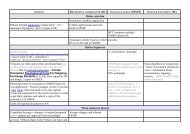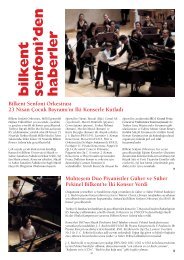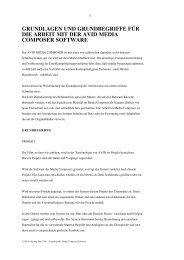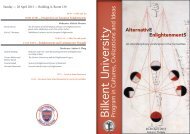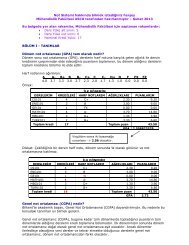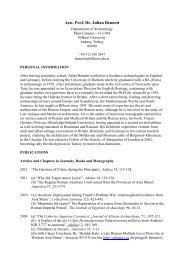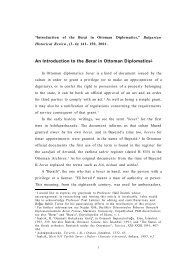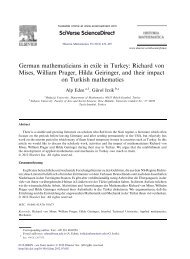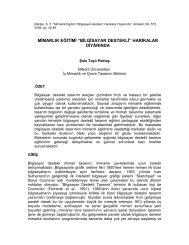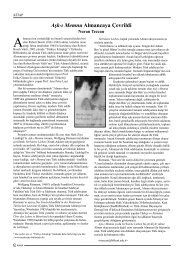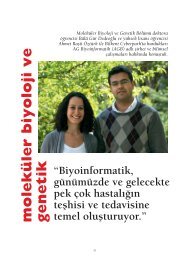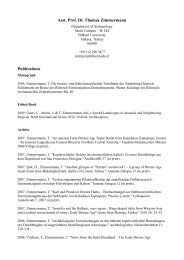Pektas, S. T. “Designing the Future: Reflections ... - Bilkent University
Pektas, S. T. “Designing the Future: Reflections ... - Bilkent University
Pektas, S. T. “Designing the Future: Reflections ... - Bilkent University
You also want an ePaper? Increase the reach of your titles
YUMPU automatically turns print PDFs into web optimized ePapers that Google loves.
FOREWORD<br />
Designing <strong>the</strong> <strong>Future</strong>: <strong>Reflections</strong> of <strong>the</strong> Developments in Computer Aided Design on Education<br />
Considering <strong>the</strong> unprecedented growth<br />
of digital design methods and tools in recent<br />
years, designing <strong>the</strong> future of Computer Aided<br />
Design (CAD) education seems to be a<br />
challenging issue. Scholars from several<br />
universities in Turkey realized this endeavour at<br />
<strong>the</strong> symposium entitled <strong>“Designing</strong> <strong>the</strong> <strong>Future</strong>:<br />
<strong>Reflections</strong> of <strong>the</strong> Developments in Computer<br />
Aided Design on Education” which was held at<br />
<strong>the</strong> Department of Interior Architecture and<br />
Environmental Design, <strong>Bilkent</strong> <strong>University</strong>, on May<br />
16, 2008. This issue of Arkitekt presents a<br />
selection of <strong>the</strong> papers delivered in <strong>the</strong><br />
symposium and invited for publication after peerreviews.<br />
Despite <strong>the</strong> limitations in size, <strong>the</strong><br />
studies in this special file well represent <strong>the</strong><br />
spectrum of different approaches to CAD<br />
research in Turkey.<br />
Parametric modelling is a robust CAD<br />
paradigm which prioritizes computational design<br />
over conventional drafting-oriented methods.<br />
Yalınay-Çinici, Özsel-Akipek and Yazar discuss<br />
<strong>the</strong> effects of parametric design approach on<br />
design education through <strong>the</strong> outcomes of an<br />
experimental design studio. They point out <strong>the</strong><br />
importance of relational thinking in architectural<br />
design and advocate <strong>the</strong> use of parametric<br />
design tools not only for cultivating relational<br />
thinking skills in students but also for enabling<br />
<strong>the</strong>m to experience <strong>the</strong> materiality of designs via<br />
combinational use of such tools with computer<br />
aided manufacturing (CAM) techniques in<br />
architectural education.<br />
Interior architecture is a relatively new<br />
discipline whose relations to CAD have been<br />
rarely discussed. Şenyapılı articulates how CAD<br />
transformed <strong>the</strong> contents of design studio<br />
projects in interior architecture education by<br />
comparing traditional design studios and a<br />
computer aided design studio. The impacts of<br />
digital design tools are described in <strong>the</strong> paper<br />
under three titles: drawing, virtuality and time as<br />
<strong>the</strong> 4 th dimension. Şenyapılı claims that as a<br />
result of <strong>the</strong>se developments, interior architecture<br />
began to acquire new meanings without <strong>the</strong><br />
limitations of a pre-existing shell which<br />
traditionally formed <strong>the</strong> basis of <strong>the</strong> definition of<br />
<strong>the</strong> discipline.<br />
Despite <strong>the</strong> ever-growing body of<br />
literature on CAD, most of <strong>the</strong> existing studies<br />
have focused on relatively technical issues<br />
ignoring <strong>the</strong> socio-cultural and/or behavioural<br />
aspects of CAD education. Pektaş and Demirbaş<br />
recognize this gap in <strong>the</strong> literature and present<br />
<strong>the</strong> results of a survey which analyzes computer<br />
attitudes, learning styles and computer<br />
experiences of interior architecture<br />
undergraduates besides gender as <strong>the</strong><br />
confounding variable. The authors propose that<br />
insights into <strong>the</strong> effects of individual differences<br />
on CAD education will be helpful for educational<br />
improvements.<br />
It is widely acknowledged that building<br />
design is a multidisciplinary domain in which<br />
collaboration is of utmost importance. Two<br />
papers in this issue handle <strong>the</strong> problem of<br />
collaboration in design education. Building<br />
Information Modelling (BIM) is offering new<br />
opportunities for sharing design information;<br />
however, <strong>the</strong>re have been only few studies on <strong>the</strong><br />
educational uses of BIM. Within this perspective,<br />
İlal, Kale and Yavaş reports <strong>the</strong> findings from a<br />
BIM-based collaboration experiment between<br />
Architecture and Civil Engineering students. The<br />
authors suggest that <strong>the</strong> increased utilization of<br />
explicit domain knowledge made available by<br />
BIM tools is likely to have a positive impact on <strong>the</strong><br />
future role of architects within <strong>the</strong> multidisciplinary<br />
design teams. Karakaya and Demirkan propose a<br />
framework for <strong>the</strong> use of collaborative creativity<br />
support tools in design education. This on-going<br />
study is expected to result in a collaborative<br />
creativity support tool which is a plug-in for<br />
Google SketchUp 3D modelling software.<br />
An overview of <strong>the</strong> works in this issue<br />
demonstrates that important topics of CAD<br />
education research have been addressed by<br />
researchers in Turkey with increasing degrees of<br />
academic rigour. We hope that this special file<br />
will facilitate for building a national network of<br />
CAD researchers who will cooperate for <strong>the</strong><br />
better.<br />
We would like to thank Birgül Çolakoğlu<br />
and Halime Demirkan for moderating <strong>the</strong><br />
sessions in <strong>the</strong> symposium, to Tijen Sonkan and<br />
Fatih Karakaya for <strong>the</strong>ir work in <strong>the</strong> organization<br />
committee and to <strong>the</strong> authors as well as <strong>the</strong> o<strong>the</strong>r<br />
participants of <strong>the</strong> symposium for <strong>the</strong>ir dedicated<br />
contributions. We extend our gratitude to Zafer<br />
Ertürk, Orhan Hacıhasanoğlu, Aydın Türker and<br />
to <strong>the</strong> staff of Arkitekt who made this publication<br />
possible.<br />
Guest Editor: Şule Taşlı Pektaş<br />
<strong>Bilkent</strong> <strong>University</strong><br />
Faculty of Art, Design and Architecture<br />
Department of Interior Architecture and<br />
Environmental Design



